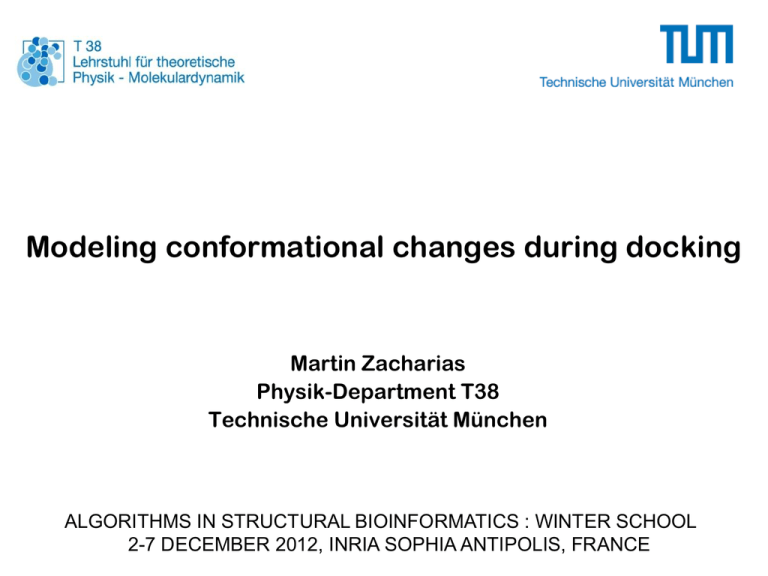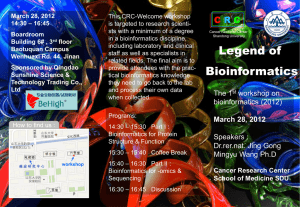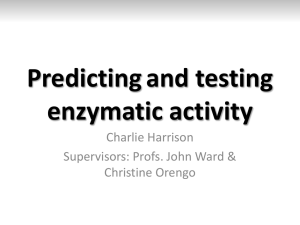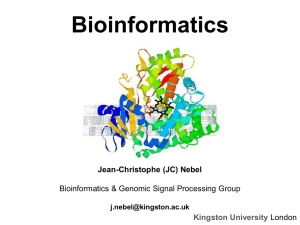Slides - Sophia Antipolis
advertisement

Modeling conformational changes during docking Martin Zacharias Physik-Department T38 Technische Universität München ALGORITHMS IN STRUCTURAL BIOINFORMATICS : WINTER SCHOOL 2-7 DECEMBER 2012, INRIA SOPHIA ANTIPOLIS, FRANCE Outline • Conformational changes in proteins upon association • Methods to model conformational changes • Strategies to account for conformational changes • Explicit flexibility during docking • Attract docking approach ALGORITHMS IN STRUCTURAL BIOINFORMATICS : WINTER SCHOOL 2-7 DECEMBER 2012, INRIA SOPHIA ANTIPOLIS, FRANCE Lock-and-key and induced fit binding Emil Fischer 1894: “To use an image, I would say that enzyme and glycoside have to fit into each other like a lock and a key, in order to exert a chemical effect on each other.” • Comparison of protein conformations in the bound and unbound states indicates: – A variety of conformational changes can accompany protein association. – Ranging from Iocal adjustments of side chains involving atom displacements of < 1 Å to folding/refolding of protein segments • „true induced-fit“ vs. conformational selection of near bound conformations from an ensemble of unbound conformations. ALGORITHMS IN STRUCTURAL BIOINFORMATICS : WINTER SCHOOL 2-7 DECEMBER 2012, INRIA SOPHIA ANTIPOLIS, FRANCE Docking with bound protein structures • Docking with „bound“ protein structures is easier then using „unbound“ conformations – Algorithms that are based purely on surface complementarity can often detect near-native docking solutions as top ranking (using bound structures) • Even local conformational changes at an interface can significantly perturb surface complementarity. ALGORITHMS IN STRUCTURAL BIOINFORMATICS : WINTER SCHOOL 2-7 DECEMBER 2012, INRIA SOPHIA ANTIPOLIS, FRANCE Types of conformational changes in proteins • Protein motions Type of motion Time Scale Side chain motions (protein surface) 0.1 ps- 0.1 ns Amplitude 1-5 Å Backbone motions in protein loop regions : 10 Å several ns 1- Motions of the N- or C-terminus of a protein: 5Å several ns 1- Rigid body motions of secondary structures : Protein domain motions : 10 Å 0.05 – 1 μs 1-5 Å 1 μs – 1 ms 5- (for example hinge bending motions) Allosteric transitions: 1 μs – 100 ms 5-10 Å 0.1 μs – 10 ms ~5 Å (correlated motion of several subunits) Local folding and unfolding transitions (helix-coil transitions, loop folding) ALGORITHMS IN STRUCTURAL BIOINFORMATICS : WINTER SCHOOL DECEMBER 2012,of INRIA SOPHIA FRANCE (from McCammon 2-7 & Harvey, Dynamics proteins andANTIPOLIS, nucleic acids, Cambridge University Types of conformational changes upon complex formation • Side chain conformations in bound and unbound structures may differ. – Often seen for side chains such as Lys and Arg with long flexible aliphatic tail. • Can result in sterical overlap in case of rigid docking. bound vs. unbound side chains ALGORITHMS IN STRUCTURAL BIOINFORMATICS : WINTER SCHOOL 2-7 DECEMBER 2012, INRIA SOPHIA ANTIPOLIS, FRANCE Localized backbone changes upon association • Frequently, not only side chains but also local backbone segments (loops) undergo conformational changes during complex formation. • Sterical overlap; strong deviation of docked complex from native complex structure ALGORITHMS IN STRUCTURAL BIOINFORMATICS : WINTER SCHOOL 2-7 DECEMBER 2012, INRIA SOPHIA ANTIPOLIS, FRANCE Global backbone changes upon association • Global changes – may involve domain-domain rearrangement – collective adjustment of large protein segments ALGORITHMS IN STRUCTURAL BIOINFORMATICS : WINTER SCHOOL 2-7 DECEMBER 2012, INRIA SOPHIA ANTIPOLIS, FRANCE Docking using protein model structures • Frequently protein-protein docking requires to use homology modeled structures. – Quality of model structures depends on sequence similarity to template structure and on the modeling procedure. • Possible errors in target-template alignment • Structural inaccuracies in segments with low sequence similarity Backbone shift loops and side chains • Possible errors in modeled surface Incorrect loop Incorrect side chain placement ALGORITHMS IN STRUCTURAL BIOINFORMATICS : WINTER SCHOOL 2-7 DECEMBER 2012, INRIA SOPHIA ANTIPOLIS, FRANCE Docking using protein model structures • Docking of model structures is typically more difficult then docking using experimental structures – Most difficult CAPRI-targets involved homology models – Docking procedure must either tolerate large errors in protein conformation – or allow explicitly for significant conformational changes at the interface during docking that “reverse” the modeling errors ALGORITHMS IN STRUCTURAL BIOINFORMATICS : WINTER SCHOOL 2-7 DECEMBER 2012, INRIA SOPHIA ANTIPOLIS, FRANCE Outline • Conformational changes in proteins upon association • Methods to model conformational changes • Strategies to account for conformational changes • Explicit flexibility during docking • Own docking approach ALGORITHMS IN STRUCTURAL BIOINFORMATICS : WINTER SCHOOL 2-7 DECEMBER 2012, INRIA SOPHIA ANTIPOLIS, FRANCE Computational methods to model protein conformations • Systematic conformational generator approaches – based on peptide backbone segments – based on systematic dihedral angle sampling – based on stable side chain rotamer states Example: CONGEN (Bruccoleri& Karplus 1987. Biopolymers 26, 127) • Molecular dynamics simulations • Monte Carlo simulations • Normal mode calculations • Distance geometry methods – Method generates possible structures compatible with a set of distances between atoms Examples: CONCOORD (de Groot et al. 1997. Proteins 29, 240) • Basis of most methods is a molecular mechanics force field ALGORITHMS IN STRUCTURAL BIOINFORMATICS : WINTER SCHOOL 2-7 DECEMBER 2012, INRIA SOPHIA ANTIPOLIS, FRANCE Molecular mechanics force field for a protein Force field energy of a molecule: H3C V(r1,r2,..,rn) = CH3 CH Cα C O Energy Energy ΣNbonds ½kbi (bi – bi,0)2 N +ΣNangles ½kθi (θi – θi,0)2 H +ΣNtorsions Σn=1..Ni kτni (1 + cos [ni τi – δi]) +Σnbpairs εij [(σij/dij)12 -(σij/dij)6] + qi qj /(4πεodij) distance distance ALGORITHMS IN STRUCTURAL BIOINFORMATICS : WINTER SCHOOL 2-7 DECEMBER 2012, INRIA SOPHIA ANTIPOLIS, FRANCE Normal mode analysis • Taylor expansion of the energy function at energy minimum – First derivative of energy function is zero. – Curvature locally determined by second derivative (Hessian) of the energy function – Diagonalization of the Hessian yields eigenvectors that correspond to collective (orthogonal) degrees of freedom. y – Eigenvectors can be ordered according to eigenvalues (corresponding to force constants (or frequencies) for deformations along corresponding eigenvectors) eigenvectors of Hessian y x ALGORITHMS IN STRUCTURAL BIOINFORMATICS : WINTER SCHOOL 2-7 DECEMBER 2012, INRIA SOPHIA ANTIPOLIS, FRANCE x Approximate normal mode calculations based on elastic network models • Elastic networks describe the interaction between atoms in a protein by harmonic springs. • Model by Hinsen (Proteins 1998, 33, 417.): Backbone of Xylanase E(R1,..RN) = ΣCα-pairs Eij(Ri – Rj) Eij(r) = k(Rijo) ( |r| - Rijo )2 Mode 1 k(r) = c Exp[ - |r| 2 / ro2 ] • Spring force constant decreases with distance (other methods use a cutoff) • Results in global collective modes that are similar to normal modes calculated at atomic resolution. Tirion, Phys Rev Lett 1996;77:1905-1908. Bahar et al. Folding Design 1997;2:173-181. Hinsen K. Proteins. 1998;33:417-429. Mode 2 ALGORITHMS IN STRUCTURAL BIOINFORMATICS : WINTER SCHOOL 2-7 DECEMBER 2012, INRIA SOPHIA ANTIPOLIS, FRANCE Observed global motions vs. approximate harmonic modes 4 Can experimentally observed global changes be approximated by precalculated soft modes? 0 Modes 3,5 first Mode 3 Rmsd(Å) • 1-2 Modes 1-10 Modes 2,5 2 1,5 1 0,5 0 Maltose-binding protein (bound vs. unbound (1anf vs 1omp) 0 modes 3.7 Å 1EER; B/C 1AQ F,A/B 1FCJ;1D6S 1AKZ;1SSP 1CKL; D/F 1AXN;2RAN 1O MP;1ANF Protein structure pair 2 modes 1.2 Å Investigated by: Tama & Sanejouand 2001. Protein Eng. 14, 1. Lindahl & Delarue 2005, NAR 33, 4496. Dobbins et al. 2008, PNAS 105, 10390. Pyruvate kinase (1aqf; chain A/B) 0 modes 2.5 Å 1 modes 0.7 Å Proteinkinase A (apo vs. bound structure) • cAMP-dependent protein kinase (PKA) undergoes global conformational changes upon ligand binding – Apo form: pdb1j3h – Balanol bound form:pdb1bx6 • 10 modes (Apo-form) can reduce backbone RMSD from 1.65 Å to 0.65 Å • First mode alone: 0.93 Å Mode deformed vs. bound PKA Apo vs. bound PKA ALGORITHMS IN STRUCTURAL BIOINFORMATICS : WINTER SCHOOL 2-7 DECEMBER 2012, INRIA SOPHIA ANTIPOLIS, FRANCE Molecular dynamics simulations • The equations of motion for a system of interacting particles can be integrated numerically in small time steps. • The resulting set of (discrete) coordinates (trajectory) for each atom (particle) is an approximation to the “real” path the atom takes in time: Atom with velocity v0 v1 Path or trajectory of an atom Force at later time causes acceleration and change in velocity ALGORITHMS IN STRUCTURAL BIOINFORMATICS : WINTER SCHOOL 2-7 DECEMBER 2012, INRIA SOPHIA ANTIPOLIS, FRANCE Replica-exchange molecular dynamics • Multi-temperature replica exchange MD: – Replicas of the system are run at N temperatures (T1.. ,Ti, Tj.., TN) temperature 420 K 400 K – Exchange between replicas i, j (at neighboring T), accepted according to: 380 K w( xi x j ) 1 for 0; 360 K w( xi x j ) exp() for 0 340 K where ( i j ) E (rj ) E (ri ) Momenta are adjusted according to: p[i] = sqrt [ T(i)/T(j)] p[j] 320 K 300 K Simulation time Hukushima & Nemoto 1996, JPSJ 65, 1604. Suigato & Okamoto 1999, CPL 314, 141. ALGORITHMS IN STRUCTURAL BIOINFORMATICS : WINTER SCHOOL 2-7 DECEMBER 2012, INRIA SOPHIA ANTIPOLIS, FRANCE Molecular dynamics simulations can be used to study local and global motions of a protein • Side chain and loop motion on the nanosecond time scale • Selection of alternative side chain and loop structures – Camacho et al. (2004, 2005) used MD simulations to predict near native side chain structures for anchor residues in unbound protein structures. • Global motions can be extracted by principle component analysis of the positional covariance matrix (essential dynamics, Amadei et al., 1993) – Smith et al. (2005) have used to MD simulations to analyse global conformational fluctuations in proteins and the relation to conformational changes upon association. Rajamani et al. 2004. PNAS 101, 11287. Camacho, 2005. Proteins, 60, 245. Amadei et al. 1993. Proteins 17, 412. Smith et al. 2005. JMB 347, 1077. ALGORITHMS IN STRUCTURAL BIOINFORMATICS : WINTER SCHOOL 2-7 DECEMBER 2012, INRIA SOPHIA ANTIPOLIS, FRANCE Combining elastic network calculations and molecular dynamics simulations • ENM calculations can help to rapidly identify soft flexible degrees of freedom of a protein. – Low resolution view of a structure • Distance fluctuations compatible with the ENM model can be calculated by excitation in each mode • The distance fluctuations indicate the range of sterically allowed deformations. ALGORITHMS IN STRUCTURAL BIOINFORMATICS : WINTER SCHOOL 2-7 DECEMBER 2012, INRIA SOPHIA ANTIPOLIS, FRANCE How to combine ENM analysis and MD simulation? • Add a biasing (flooding) potential for distance fluctuations derived from ENM analysis for each replica. • Biasing potential for Cα-Cα distances or heavy atom distances E d ij k d ij d ij 0 2 E d ij 0 , otherwise • d ij , 2 2 if d ij d ij 0 d ij w( xi x j ) 1 for 0; w( xi x j ) exp() for 0 distance Biasing level Use Hamiltonian replica exchange with different levels of the biasing potential where Form of the biasing potential 1 0.75 0.5 0.25 E j (rj ) E j (ri ) E i (rj ) E i (ri ) Zacharias, J. Chem. Theory Comput. 2008, 4, 477. No biasing Simulation time Application to T4 lysozyme • More than 200 structures of T4L in the data base • Can adopt open and closed structures – Simulations using Amber parm03 force field at 310 K, GB model – 2LZM start (a closed form) – 5 biasing levels (including the orignal force field) – ENM calculation for CA atoms every 20 ps. • Total simulation time: 3.2 ns Zacharias, J. Chem. Theory Comput. 2008, 4, 477. ALGORITHMS IN STRUCTURAL BIOINFORMATICS : WINTER SCHOOL 2-7 DECEMBER 2012, INRIA SOPHIA ANTIPOLIS, FRANCE Application to T4 lysozyme • T4L flips between open and closed states many times • Comparison with conventional MD simulation starting from closed and from an open form – No open-closed transition during conventional MD on the 3.2 ns time scale ALGORITHMS IN STRUCTURAL BIOINFORMATICS : WINTER SCHOOL 2-7 DECEMBER 2012, INRIA SOPHIA ANTIPOLIS, FRANCE Outline • Conformational changes in proteins upon association • Methods to model conformational changes • Strategies to account for conformational changes • Explicit flexibility during docking • Attract docking approach ALGORITHMS IN STRUCTURAL BIOINFORMATICS : WINTER SCHOOL 2-7 DECEMBER 2012, INRIA SOPHIA ANTIPOLIS, FRANCE Strategies to account for conformational changes during docking Two possibilities: Inclusion of conformational changes during entire docking search • Rigid docking followed by allowing conformational changes in a second step The majority of docking methods follows the second approach and may include several flexible refinement steps Reviewed in: Andrusier et al. 2008. Proteins 73,271. Bonvin, 2006. Curr. Opin. Struct. Biol. 16, 194. Zacharias, 2010. Curr. Opin. Struct. Biol. 20, 180. ALGORITHMS IN STRUCTURAL BIOINFORMATICS : WINTER SCHOOL 2-7 DECEMBER 2012, INRIA SOPHIA ANTIPOLIS, FRANCE Soft docking: Accounting implicitely for small conformational changes • • • Rigid docking with a soft protein boundary – Correlation methods: • Smoothing/softening the protein surface boundary • Increasing the tolerance for receptorligand overlap Rigid docking with soft or truncated nonbonded potentials Pruning (removing) of side chains during docking Truncated Lennard-Jones potential 1 <0 Soft-core Lennard-Jones potential ALGORITHMS IN STRUCTURAL BIOINFORMATICS : WINTER SCHOOL 2-7 DECEMBER 2012, INRIA SOPHIA ANTIPOLIS, FRANCE 1 Accounting for conformational changes on a subset of docking solutions • The first rigid docking phase results in a large set of structures. • It is hoped that the pool of solutions contains complex geometries sufficiently close to the native complex. – Experimental information, application of different scoring schemes can help to limit the number of docking solutions. ALGORITHMS IN STRUCTURAL BIOINFORMATICS : WINTER SCHOOL 2-7 DECEMBER 2012, INRIA SOPHIA ANTIPOLIS, FRANCE Accounting for conformational changes on a subset of docking solutions • In principle, changes of both backbone and side chain structure need to be allowed. • Procedure must be sufficiently fast to deal with several hundred or even thousands of complexes. • Ideally, docking refinement should improve complex geometry and ranking. ALGORITHMS IN STRUCTURAL BIOINFORMATICS : WINTER SCHOOL 2-7 DECEMBER 2012, INRIA SOPHIA ANTIPOLIS, FRANCE Modeling side chain conformational changes • Side chain refinement by: – Systematic methods – All systematic methods assume rigid backbone – Reduction of search space by considering only discrete side chain conformations (rotamers) • Side chain rotamer structures have been derived from analysis of known structures • Backbone dependent and independent rotamer libaries – Global optimization problem to minimize sterical overlap between side chains Energy-score of a side chain structure: Erotamer combination = ΣiNresidue Ei (rotamer r) + Σi,j, Ei,j (i->rotamer r, j->rotamer s) ALGORITHMS IN STRUCTURAL BIOINFORMATICS : WINTER SCHOOL 2-7 DECEMBER 2012, INRIA SOPHIA ANTIPOLIS, FRANCE Modeling side chain conformational changes • Systematic exploration of all possible combinations – Possible for a small set of side chains – Efficient if side chains do not overlap (independent search for each side chain) • Ensemble methods (Loriot et al., 2011) • Self-consistent mean field optimization – Algorithm: • 1.Stores a weight for each side chain rotamer • 2.Calculates the interactions of each side chain rotamer with all other residues (multiplied with the weight) • 3.Update of weights (Boltzmann Probability based on Interactions) • 4. go to 1 or terminate if weights do not change. – Used in 3D-DOCK (Jackson et al. 1998), Mc2 and Attract (Bastard et al. 2003, 2006) Jackson et al. 1998. JMB 276, 265.;Bastard et al. 2003. JCC 24, 1910. ;Bastard et al. 2006. Proteins 62, 956.; Loriot et al., Trans. Comput Biol. Bioinfo, 2011 ALGORITHMS IN STRUCTURAL BIOINFORMATICS : WINTER SCHOOL 2-7 DECEMBER 2012, INRIA SOPHIA ANTIPOLIS, FRANCE Modeling side chain conformational changes • Dead-end-elimination methods – A method to systematically eliminate side chain rotamers that cannot be part of the global minimum – A rotamer is removed if another rotamer has a lower energy for every rotamer combination of all other residues. – Variants of DEE are implemented for example in SCWRL (Canutescu et al., 2003) and FireDock (Andrusier et al., 2007) Canutescu et al. 2003 Protein Sci. 12, 2001. Andrusier et al. 2007 Proteins 69, 139. ALGORITHMS IN STRUCTURAL BIOINFORMATICS : WINTER SCHOOL 2-7 DECEMBER 2012, INRIA SOPHIA ANTIPOLIS, FRANCE Molecular dynamics simulations of docked complexes • Conformational adjustments by molecular dynamics (MD) simulations: • Allows for larger conformational changes (by crossing energy barriers) compared to EM. • Backbone and side chain motions can be included • Solvent molecules can be included. • Coupling with advanced sampling methods (simulated annealing, replica-exchange) • Quality of final results depends on force field conditions and experimentally derived restraints ALGORITHMS IN STRUCTURAL BIOINFORMATICS : WINTER SCHOOL 2-7 DECEMBER 2012, INRIA SOPHIA ANTIPOLIS, FRANCE Monte Carlo methods • Heuristic method (similar to MD no guarantee for finding best possible solution) • Use of simulated annealing to overcome energy barriers • Fast because only interactions close to mobile side chains need to be calculated • Various (non-differentiable) energy functions can be used • Step size can be adapted, e.g. switching between rotamer states (larger conformational changes per step then in MD simulations) • Possibility to combine it with (limited) backbone motion ALGORITHMS IN STRUCTURAL BIOINFORMATICS : WINTER SCHOOL 2-7 DECEMBER 2012, INRIA SOPHIA ANTIPOLIS, FRANCE Approaches that employ Monte Carlo simulations • RosettaDock (Gray et al., 2003; Wang et al.2005) – Uses MC steps in side chain rotamers + gradient based EM of dihedral angles; MC steps in backbone dihedrals can also be included. • Biased probability MC methods (Fernandez-Recio et al., 2002;2007) – Uses random changes in backbone and side chain dihedrals and subsequent EM. • Replica-Exchange MC simulations (Lorenzen & Zhang, 2007) – T-RexMC simulation on side chain dihedrals and rotational + Wang et al.translational 2005. Protein Scidegrees 14, 1328. of freedom of the partners Jackson et al. 1998. J Mol Biol 276, 265. Gray et al. 2003. J Mol Biol 331, 281. Fernandez-Recio et al. 2002 Prot. Sci. 11,280; 2007, Proteins 52, 113. Lorenzen & Zhang 2007. Prot. Sci. 16, 2716. ALGORITHMS IN STRUCTURAL BIOINFORMATICS : WINTER SCHOOL 2-7 DECEMBER 2012, INRIA SOPHIA ANTIPOLIS, FRANCE Outline • Conformational changes in proteins upon association • Methods to model conformational changes • Strategies to account for conformational changes • Explicit flexibility during docking • Attract docking approach ALGORITHMS IN STRUCTURAL BIOINFORMATICS : WINTER SCHOOL 2-7 DECEMBER 2012, INRIA SOPHIA ANTIPOLIS, FRANCE Strategies to account for conformational changes during docking Two possibilities: Inclusion of conformational changes during entire docking search • The majority of docking methods follows the second approach and may include several flexible refinement steps. Reviewed in: Andrusier et al. 2008. Proteins 73,271. Bonvin, 2006. Curr. Opin. Struct. Biol. 16, 194. Zacharias, 2010. Curr. Opin. Struct. Biol. 12, 29. Rigid docking followed by allowing conformational changes in a second step Inclusion of conformational changes during docking • Cross-docking to members of an ensemble of structures (Krol et al., 2007) – Can handle both changes in backbone as well as side chains – No modification to existing methods necessary – Linear increase of computational demand and also docking solutions • Docking using MD simulations including experimental restraints – Implemented in HADDOCK (Dominguez et al., 2003) – Involves different MD phases (rigid, inclusion of dihedral degrees of freedom, Cartesian coordinates) – Very successful if sufficient experimental Krol et al. restraints 2007. Proteins 69,available 750. are Dominguez et al. 2003. JACS 125, 1731. ALGORITHMS IN STRUCTURAL BIOINFORMATICS : WINTER SCHOOL 2-7 DECEMBER 2012, INRIA SOPHIA ANTIPOLIS, FRANCE Inclusion of backbone conformational changes during docking • Identification of flexible hinge regions in proteins – Several methods available to detect flexible backbone hinge regions: • ENM/GNM analysis (e.g. HingeProt; Emekli et al. 2008) • Comparison of experimental structures (DynDom; Hayward & Berendsen, 1998), HingeFind; Wriggers & Schulten, 1997; FlexProt; Emekli et al., 2008) • Separate docking of rigid domains after hinge detection (Schneidman-Duhovny et al. 2007) • Retain only those solutions that allow appropriate domain connectivity Hayward & Berendsen, 1998. Proteins 30, 144. Wriggers & Schulten, 1997. Proteins 29, 1. Shatsky et al. 2004. J.Comp.Biol. 11, 83. Emekli et al. 2008. Proteins 70, 1219. Schneidman-Duhovny et al. 2007. Proteins 69, 764. ALGORITHMS IN STRUCTURAL BIOINFORMATICS : WINTER SCHOOL 2-7 DECEMBER 2012, INRIA SOPHIA ANTIPOLIS, FRANCE Outline • Conformational changes in proteins upon association • Methods to model conformational changes • Strategies to account for conformational changes • Explicit flexibility during docking • Attract docking approach ALGORITHMS IN STRUCTURAL BIOINFORMATICS : WINTER SCHOOL 2-7 DECEMBER 2012, INRIA SOPHIA ANTIPOLIS, FRANCE The ATTRACT approach 8 • 31 LJ-atom types • Real charges 6 R R qi q j V AB AB r r rij ij ij repulsive pair : 8 in case of attractive pair 6 R R qi q j V AB AB r r rij ij ij 8 if rij rmin 6 R R qi q j V 2 emin AB AB r r rij ij ij if rij rmin Score Multi-start systematic search by Energy Minimization distance Zacharias, Protein Science. 2003, 12, 1271. The ATTRACT approach Multi-start systematic search by Energy Minimization Zacharias, Protein Science. 2003, 12, 1271. The ATTRACT approach Multi-start systematic search by Energy Minimization Zacharias, Protein Science. 2003, 12, 1271. The ATTRACT approach Multi-start systematic search by Energy Minimization Zacharias, Protein Science. 2003, 12, 1271. The ATTRACT approach Multi-start systematic search by Energy Minimization Zacharias, Protein Science. 2003, 12, 1271. The ATTRACT approach Multi-start systematic search by Energy Minimization Zacharias, Protein Science. 2003, 12, 1271. Reduced vs. atomic resolution representation Pros Cons Fewer pairwise interactions compared to atomic resolution Structures must be transferred back to atomic resolution Fewer local minima compared to atomic resolution Scoring performance to be improved Limited implicit flexibility by soft interaction potentials ALGORITHMS IN STRUCTURAL BIOINFORMATICS : WINTER SCHOOL 2-7 DECEMBER 2012, INRIA SOPHIA ANTIPOLIS, FRANCE Knowledge-based scoring complex 1 • complex 2 Concept: – Comparison of observed vs. expected contact (or distance-dependent) frequencies between residues or atoms in protein-protein complexes Score (i,j) = -RT ln (f(ij)obs/f(ij)expect) • Score Advantage – Can be calculated rapidly. – Relatively robust with respect to „accuracy“ of the interface structure. distance ALGORITHMS IN STRUCTURAL BIOINFORMATICS : WINTER SCHOOL 2-7 DECEMBER 2012, INRIA SOPHIA ANTIPOLIS, FRANCE Optimization of the scoring function Aim Scoring optimization of near-native vs. alternative docking minima for a large set of training complexes receptor Target function Top ranking of native solution (large gap to incorrect solutions) Step 1 Generation of „high-ranked“ incorrect solutions Step 2 Optimization of pairwise interactions with respect to target function Score Step 3 Test of scoring on separate set of test complexes ALGORITHMS IN STRUCTURAL BIOINFORMATICS : WINTER SCHOOL 2-7 DECEMBER 2012, INRIA SOPHIA ANTIPOLIS, FRANCE distance Performance on bound and unbound docking • On bound test cases Rank distribution of acceptable solutions – 55% top 1 – ~90% in top 10 – ~85% RmsdLig< 2.5 Å • For unbound test cases (82): acceptable solutions (Capri criteria). – 22% in top 10 35 30 25 20 weight 1.5 on PPISP prediction 15 – 65% in top 100 – ~15% RmsdLig< 2.5 Å no weight 10 5 0 Schneider & Zacharias, J Mol Recog. 2012,25,15. Rank 1 Rank 2-10 Rank 11100 Rank >100 not acceptable ALGORITHMS IN STRUCTURAL BIOINFORMATICS : WINTER SCHOOL 2-7 DECEMBER 2012, INRIA SOPHIA ANTIPOLIS, FRANCE Efficient inclusion of flexibility Docking with multiple loop copies Local flexibility: • Side chains and small loops represented by several conformational copies – Mean field representation – Simultaneous optimization of docking geometry and side chain and loop structure Global flexibility: • Inclusion of global soft collective degrees of freedom from normal mode analysis – Accounting for most important global motion using very few new variables (1-10) Softest global mode of Xylanase Computationally very fast Zacharias & Sklenar, JCC,1999, 20, 287; Zacharias, Proteins 2004, 54, 759; May & Zacharias, BBA. 2005, 1754, 225. Bastard, Prevost & Zacharias, Proteins 2006, 62, 956. ALGORITHMS IN STRUCTURAL BIOINFORMATICS : WINTER SCHOOL 2-7 DECEMBER 2012, INRIA SOPHIA ANTIPOLIS, FRANCE Docking Xylanase / TAXI Inhibitor (1T6G) system rigid flexible (5 modes) 6 rigid body degrees of freedom + one additional for every soft mode m V = Vintermolecular + Vintramolecular (m) Vintramolecular (m) = 2 0 4 eig ( R R ) m m m m: number of soft modes eigm: corresponding eigenvalue of mode m R0m: equilibrium coordinate set of mode m Rm: coordinate set after deflection of mode m R0m- Rm: amplitude of mode m Apo rec., holo rec., rec. after flexible docking, exp. ligand position, docked ligand May & Zacharias (2008) Proteins. 70, 794. ALGORITHMS IN STRUCTURAL BIOINFORMATICS : WINTER SCHOOL 2-7 DECEMBER 2012, INRIA SOPHIA ANTIPOLIS, FRANCE Docking challenge CAPRI • CAPRI (Critical Assessment of Predicted Interactions) – Blind binding geometry predictions before experimental complex structures are available: Target 8 9 14 18 19 20 21 25 26 27 28 29 30 32 34 37 40 41 42 % native contacts 40 18 60 0 65 26 34 21 45 39 7 2 45 88 15 47 89 96 81 http://capri.ebi.ac.uk/) May & Zacharias, Proteins 2007, 69, 774. Interface-Rmsd(Å) 0.9(**) 9.5 0.6 (***) 22.5 1.8 (**) 9.8 5.1 4.4 (*) 2.1 (*) 3.6 (*) 7.2 11.5 2.5 (*, best prediction) 0.7 (***, best prediction %nc) 6.8 1.7 (**, third best) 0.6 (***, among 5 best) 0.8 (***, best prediction %nc) 0.47(***, best prediction) Protein-Protein Docking including CryoEM-data • Electron microscopy of macromolecular assemblies can provide low-resolution electron density • ATTRACT allows the inclusion of such data during multi-protein docking. • It is also possible to include symmetry as constraints during docking. RMSD 4.2 A RMSD 2.4 A ALGORITHMS IN STRUCTURAL BIOINFORMATICS : WINTER SCHOOL 2-7 DECEMBER 2012, INRIA SOPHIA ANTIPOLIS, FRANCE Practical using the ATTRACT Protein-Protein docking approach • Pairwise docking of an Enzyme-Inhibitor complex • Calculation of normal modes of the enzyme using an elastic network model • Inclusion of normal mode flexibility during docking • Protein-protein docking using an ensemble of protein structures • Docking multiple proteins into low resolution electron density ALGORITHMS IN STRUCTURAL BIOINFORMATICS : WINTER SCHOOL 2-7 DECEMBER 2012, INRIA SOPHIA ANTIPOLIS, FRANCE Conclusions • Accounting (efficiently!) for conformational changes during docking remains a challenge • Longterm goal: docking model structures – Docking procedure must tolerate or correct errors in the model – More realistic protein model structures • Characterization of transient interactions and encounter Reviews on Protein-Protein docking complexes Zacharias, M. (2010). Accounting for conformational changes during protein-protein docking. Curr Opin Struct Biol 20, 180-186. Vajda, S., and Kozakov, D. (2009). Convergence and combination of methods in protein-protein docking. Curr Opin Struct Biol 19, 164-170. Andrusier , Mashiac, Nussinov & Wolfson 2008. Principles of flexible protein-protein docking. Proteins 73,271. Bonvin, 2006. Flexible protein-protein docking. Curr. Opin. Struct. Biol. 16, 194. ALGORITHMS IN STRUCTURAL BIOINFORMATICS : WINTER SCHOOL 2-7 DECEMBER 2012, INRIA SOPHIA ANTIPOLIS, FRANCE





